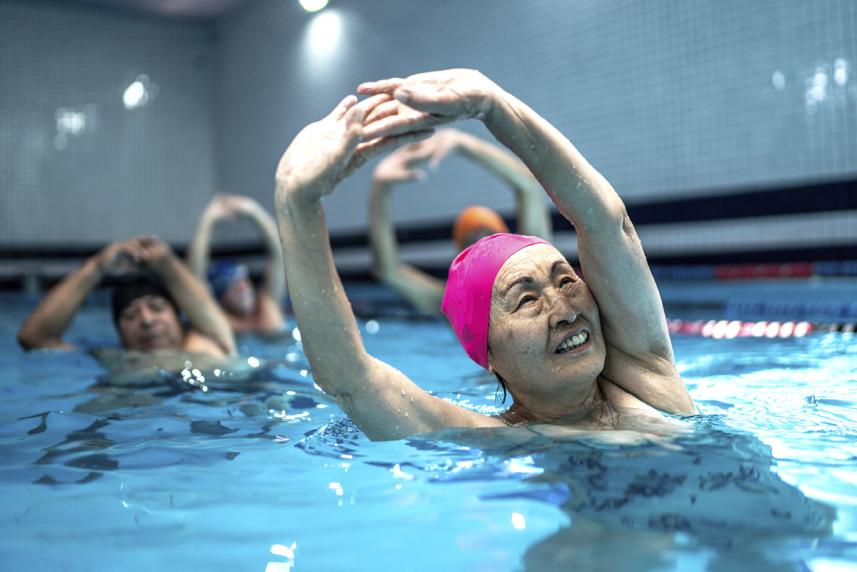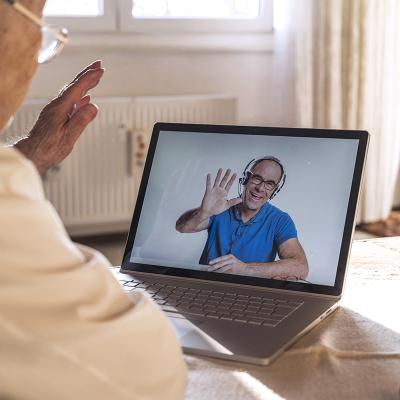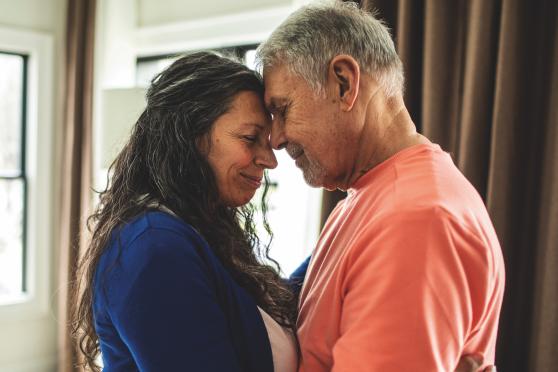How to have less pain all day
Whether you wake up stiff and sore or suffer more as the day wears on, these tips can help ease and prevent pain from morning to night.

If your joints and muscles have been achy and sore for weeks (or months or even years), you’re not alone. As many as 76 percent of people over age 60 have chronic, or long-lasting, pain.* Sometimes the cause is clear — maybe you’re healing from surgery or an injury, or you have osteoarthritis. Other times, there’s no obvious explanation. Either way, pain is no fun, and it can get in the way of working or doing what you love.
While pain medications can help, they’re often not ideal to use long term, says pain management specialist Medhat Mikhael, MD. He’s the medical director of the non-operative program at the Spine Health Center at Memorial Care Orange Coast Medical Center in Fountain Valley, CA. Even over-the-counter (OTC) pain medicines carry a risk of side effects like stomach bleeding and liver problems.
But the good news is that there are many other lifestyle strategies that can help. Here are some simple and effective solutions for finding relief from pain at the time of day it bothers you most.
How to have less pain in the morning
1. Do some simple stretches
Muscles and tendons tend to stiffen up during sleep, which can leave you feeling tight and uncomfortable when you wake up in the morning, says Kathryn Boling, MD. She’s a family medicine specialist at Mercy Medical Center in Baltimore. The best way to increase blood flow to areas like your back, knees and hips is to loosen them up with stretches. Try these simple moves — all of which you can do while lying on your back in bed before you get up each morning:
- Gently pull one or both knees into your chest to stretch your back.
- Slowly bend and straighten both knees.
- Rock both knees from side to side.
2. Go for a morning walk
Once you’ve warmed up your joints with stretches, some movement can make you feel better — under one condition: “Walk outdoors when it’s a warm, sunny day, not when it’s freezing cold,” says Dr. Mikhael. “A chilly temperature can actually cause muscles to tighten up more and make pain and stiffness worse.”
It’s also important to walk on a flat surface, not up or down hills, which puts a lot of stress on your joints. If the weather isn’t cooperating, walk some laps around your home instead.
3. Take a warm shower
Warm water on tight muscles and joints can work wonders when it comes to relieving morning stiffness. Moist heat is even more effective than dry heat from, say, a heating pad, says Dr. Boling. Just keep the water warm — not hot — so you don’t irritate inflamed muscles and joints, she adds.
4. Eat a good breakfast
If you do take medications or supplements such as fish oil to relieve pain, it’s important to take them with food to avoid a possible stomach upset, says Dr. Boling. “You also need to make sure you drink plenty of fluids to help keep joints lubricated,” she adds. Some good breakfast options: whole-grain cereal with low-fat milk and berries, or a berry smoothie made with low-fat milk.
How to have less pain during the day
5. Take a brain break
You may notice that as the day progresses, your pain gets worse. One reason is stress. “When you’re stressed, your body releases hormones like cortisol and adrenaline that are very inflammatory,” says Dr. Mikhael. “Plus, when you’re anxious, you tend to tighten up muscles instinctively, which puts even more stress on your joints. A vicious cycle develops, where your pain creates more stress, which in turn worsens pain.”
One way to break the cycle of pain is by trying a mindfulness exercise. Mindfulness is the practice of paying attention to the here and now without passing judgment — positive or negative — on what’s happening in the moment.* Examples of mindfulness exercises include:*
- Sitting quietly for a few minutes and paying attention to your breath
- Doing a body scan, where you mentally check in with how your body is feeling from head to toe
- Closing your eyes and listening to the sounds all around you
Research shows that these sorts of activities can help reduce your body’s perception of pain, which makes it easier to handle.*
6. Change the menu
Foods that are processed or high in fat or sugar may be tasty, but they also promote inflammation, which can worsen arthritis, says Dr. Mikhael. Fortunately, there are plenty of other delicious foods you can eat that won’t make pain worse.
Your best bet is to follow a Mediterranean diet. It’s mostly free of refined grains like white bread and pasta, processed and packaged foods, and foods with added sugars. Instead, a Mediterranean diet focuses on fruits, veggies, nuts and seeds, as well as healthy fats like fatty fish, avocados and olive oil.
“These foods are all rich in antioxidants and good fats that help reduce inflammation,” says Dr. Mikhael. One study published in the journal Biomedicines in 2020, for example, reported that eating a Mediterranean diet helped reduce pain and stiffness in people with inflammatory and rheumatoid arthritis.*
Need help paying for healthy food? Aetna® Dual Eligible Special Needs Plans have an Aetna Medicare Extra Benefits Card that can help. Check out the ways you can use your card here.
7. Keep moving
If you find that you spend most of your day sitting, try to get up and move every 30 to 60 minutes. It doesn’t have to be much — just take a quick walk across the room or do a couple of stretches, suggests Dr. Boling. “Any sort of movement increases blood flow to muscles and joints throughout the body, which helps reduce pain,” she explains.
One good exercise to try is a lunge stretch. To do it:*
- Stand with your left leg forward, knee slightly bent, your left foot flat on the floor.
- Shift your weight forward, leading with your hips, until you feel a stretch in your right upper thigh. This is your hip flexor, which can tighten up after you’ve been sitting for long periods of time.
- Hold for 10 to 30 seconds (you may need to hold a chair for support).
- Repeat with your other leg.
How to have less pain at night
8. Switch up your sleeping position
Sleeping on your stomach may cause morning pain, says Dr. Mikhael. It puts your neck in an unnatural position and puts pressure on your spine.* He recommends sleeping on your back with a pillow under your knees to keep your spine neutral. Or sleep on your side with a pillow between your knees.*
It’s also a good idea to follow the Goldilocks rule when it comes to pillows and mattresses: “Not too soft, and not too hard, but somewhere in between,” says Dr. Mikhael.
9. Play with temperature
It can be difficult to nod off at night if you’re in pain. But getting enough sleep — and especially high-quality sleep — can make a huge difference in how well you can tolerate discomfort when you’re awake, says Dr. Boling. To help bring on sleep, she recommends that you set your thermostat to about 65 degrees Fahrenheit.
“Our bodies naturally experience a slight dip in core temperature at night. So turning it down in the house as well helps signal to your body that it’s time for bed,” she says.
10. Get a good rubdown
One safe option to help relieve nighttime pain is an over-the-counter cream with a nonsteroidal anti-inflammatory drug (NSAID) like diclofenac (found in Voltaren and generic brands), says Dr. Mikhael. Research shows that they work well to relieve pain. Plus, the very act of massaging the cream into your skin may help relax you enough that you easily drift off into dreamland.
*FOR CHRONIC PAIN STATISTICS SOURCE: N Chan HKI and Chan CPI. Managing chronic pain in older people. Clinical Medicine Journal. July 2022.
*FOR MINDFULNESS DEFINITION SOURCE: Mindful. What is mindfulness? July 8, 2020. Accessed May 10, 2024.
*FOR MINDFULNESS EXERCISES SOURCE: Mayo Clinic. Mindfulness exercises. October 11, 2022. Accessed May 10, 2024.
*FOR MINDFULNESS FOR EASING PAIN SOURCE: Mayo Clinic Health System. Use mindfulness to cope with chronic pain. February 20, 2024. Accessed May 10, 2024.
*MEDITERRANEAN DIET FOR EASING PAIN SOURCE: Tsigalou C, Konstantinidis T, Paraschaki A, et al. Mediterranean diet as a tool to combat inflammation and chronic diseases. An overview. Biomedicines. July 2020; 8 (7); p: 201.
*FOR LUNGE INSTRUCTIONS SOURCE: Arthritis Foundation. Relieve tension and stiffness with stretching. Accessed May 10, 2024.
*FOR STOMACH SLEEPING AND PAIN SOURCE: Cleveland Clinic. Is sleeping on your stomach bad? June 11, 2023. Accessed May 10, 2024.
*FOR SLEEPING POSITION AND PAIN SOURCE: Cleveland Clinic. Best sleeping positions for pain. May 25, 2023. Accessed May 10, 2024.
See Evidence of Coverage for a complete description of plan benefits, exclusions, limitations and conditions of coverage. Plan features and availability may vary by service area. This material is for informational purposes only and is not medical advice. Health information programs provide general health information and are not a substitute for diagnosis or treatment by a physician or other health care professional. Contact a health care professional with any questions or concerns about specific health care needs. Providers are independent contractors and are not agents of Aetna. Provider participation may change without notice. Aetna is not a provider of health care services and, therefore, cannot guarantee any results or outcomes. The availability of any particular provider cannot be guaranteed and is subject to change. Information is believed to be accurate as of the production date; however, it is subject to change. For more information about Aetna plans, refer to our website. Participating health care providers are independent contractors and are neither agents nor employees of Aetna. The availability of any particular provider cannot be guaranteed, and provider network composition is subject to change.
If your plan’s Extra Benefits Card includes roll over, any unused amount will rollover into the next month. The monthly amount can be rolled over through the end of the plan year but will not carry over into the next plan year.
Non-Discrimination Notice | CA-Specific Non-Discrimination Notice
©2025 Aetna Inc.
Y0001_3493230_2024_C
3704352-21-01



